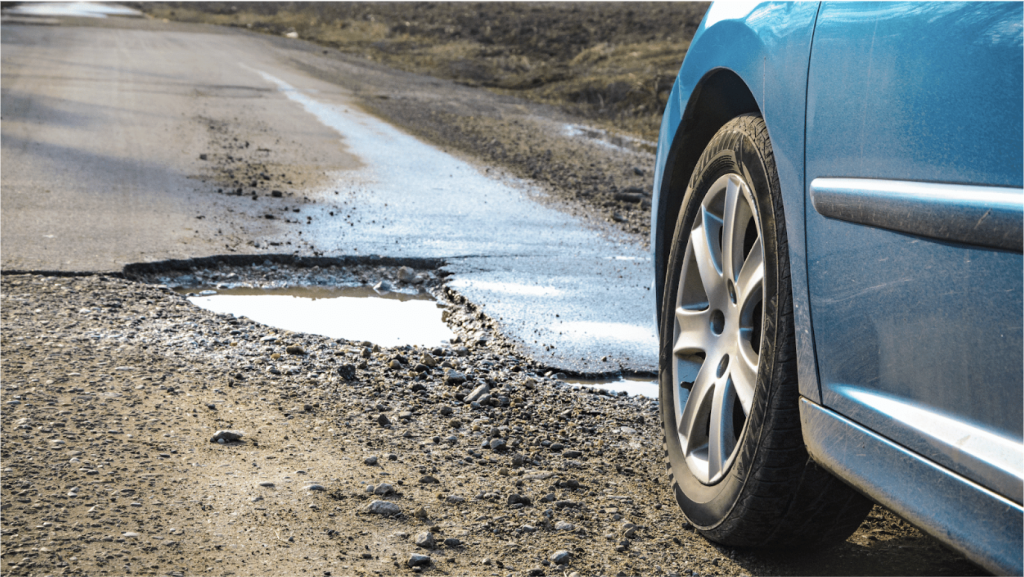Hitting a pothole can be a frustrating and costly experience, often causing damage to your vehicle such as punctured tyres, bent wheel rims, or broken suspension components. In Northern Ireland, where potholes are a significant issue—106,923 were reported between April 2023 and March 2024—you may be eligible to claim compensation from the Department for Infrastructure (DfI) if the road’s poor condition is their responsibility. This comprehensive guide outlines the process for claiming pothole damage in Northern Ireland, including the steps to follow, evidence requirements, potential challenges, alternative options like insurance claims, and practical tips to strengthen your case.
Understanding Pothole Damage Claims in Northern Ireland
In Northern Ireland, the DfI maintains most public roads, including motorways, A-roads, and local roads, under the Roads (Northern Ireland) Order 1993. If a pothole on a DfI-maintained road damages your vehicle, you can submit a compensation claim to the DfI Roads Claims Unit. However, compensation is not guaranteed, and you must prove that the DfI was negligent in maintaining the road. Between April 2023 and March 2024, the DfI received thousands of claims, with over 1,500 successful payouts, but each case is assessed individually based on evidence and liability.
Key Points About Pothole Claims
Liability: The DfI is only liable if they failed to maintain the road to a reasonable standard, as per Article 8 of the Roads (Northern Ireland) Order 1993. This means you must show they knew or should have known about the pothole and failed to repair it within a reasonable timeframe.
Private Roads: If the pothole is on private land (e.g., a supermarket car park), you must claim against the landowner or property manager, not the DfI.
Claimable Costs: You can claim for vehicle repair costs (e.g., tyres, wheels, suspension), towing fees, and reasonable consequential losses (e.g., car hire costs). Personal injury claims are possible but require medical evidence.
Challenges: The DfI’s defence is often that they had a reasonable inspection and repair system in place or were unaware of the pothole. Only about 20–30% of claims succeed due to strict liability requirements.
Grounds for a Successful Claim
To succeed, you must demonstrate that:
The pothole caused the damage to your vehicle.
The road is maintained by the DfI (not private or unadopted).
The DfI was negligent, meaning they:
Knew about the pothole and failed to repair it promptly.
Should have known about it through regular inspections but didn’t act.
The pothole was a significant hazard (typically deeper than 40mm or wider than 300mm, though no strict rule applies).
Common reasons claims fail include:
Lack of evidence proving the pothole’s existence or the DfI’s negligence.
The pothole was reported but repaired within the DfI’s response time (e.g., 5 working days for urgent defects on major roads).
The damage occurred on a private road or unadopted street.
The driver was negligent (e.g., speeding or driving recklessly).
Step-by-Step Guide to Claiming Compensation from the DfI
Step 1: Assess the Damage and Confirm the Road
Check the Damage: Identify the extent of the damage (e.g., tyre puncture, wheel rim dent, suspension misalignment). Avoid driving further to prevent worsening the damage.
Confirm the Road’s Status: Verify that the pothole is on a DfI-maintained public road. Use the DfI’s online map (www.nidirect.gov.uk) or call the DfI Roads Claims Unit (0300 200 7899) to confirm. Private roads (e.g., retail car parks) or unadopted roads (e.g., new housing estates) are not eligible for DfI claims.
Note: If the road is private, contact the landowner or property manager directly (e.g., a supermarket or estate management company).
Step 2: Gather Evidence
Strong evidence is critical to proving your claim. Collect the following:
Photos of the Pothole: Take clear, timestamped photos showing the pothole’s size, depth, and location. Use a ruler or object (e.g., a coin) for scale. Photograph surrounding road signs or landmarks to pinpoint the location.
Photos of the Damage: Document the vehicle damage (e.g., punctured tyre, bent rim) before repairs.
Witness Statements: If passengers or bystanders saw the incident, obtain written statements with their contact details.
Location Details: Note the exact location (e.g., “A21 Comber Road, Newtownards, near the Portaferry Road roundabout”). Use GPS coordinates or a map screenshot if possible.
Repair Receipts/Quotes: Obtain itemized receipts or quotes from a garage for repairs (e.g., £150 for a new tyre). If unrepaired, get a professional estimate.
Proof of Costs: Include receipts for towing, car hire, or other reasonable expenses caused by the incident.
Driving Conditions: Note the time, date, weather, and road conditions (e.g., dark, wet, or icy) to show the pothole was a hidden hazard.
Previous Reports: Check if the pothole was reported to the DfI before your incident via the DfI’s online reporting tool (www.nidirect.gov.uk) or by calling 0300 200 7899. If reported, note the reference number or date to show the DfI’s prior knowledge.
Step 3: Report the Pothole
When: As soon as possible after the incident, ideally within 24 hours, to ensure the pothole is documented and prevent repairs before your claim is filed.
How: Report online at www.nidirect.gov.uk (search “report a pothole”) or call the DfI Roads Service (0300 200 7899, Monday–Friday, 9 AM–5 PM). Provide the exact location and a description of the pothole.
Why: Reporting creates a record that the DfI was informed, strengthening your claim if they fail to act promptly. Note the reference number provided.
Step 4: Submit Your Claim
When: Within 6 years of the incident, as per the Limitation (Northern Ireland) Order 1989, but submit promptly (within weeks) to avoid delays or pothole repairs that could weaken your evidence.
How:
Download the Claim Form: Obtain the DfI Roads Claims Form from www.nidirect.gov.uk (search “pothole claim”) or request one by calling 0300 200 7899.
Complete the Form: Include:
Your contact details, vehicle registration, and date/time of the incident.
A detailed description of the incident (e.g., “On 15 July 2025 at 3 PM, I hit a pothole on the A21 near Newtownards, causing a tyre puncture costing £150”).
The pothole’s exact location and size (e.g., “30cm wide, 5cm deep”).
A list of damages and costs claimed (e.g., £150 for tyre, £50 for towing).
Attach all evidence (photos, receipts, witness statements, pothole report reference).
Submit: Send the form and evidence to:
Post: DfI Roads Claims Unit, County Hall, Castlerock Road, Coleraine, BT51 3HS.
Email: roads.claimsunit@infrastructure-ni.gov.uk.
Note: Keep copies of all documents and evidence. Do not admit fault or speculate about your driving in the claim.
Step 5: DfI Investigation and Response
Process: The DfI Roads Claims Unit investigates by:
Reviewing their inspection and repair records to check if the pothole was reported or identified during routine checks (e.g., monthly for A-roads, annually for minor roads).
Assessing whether they acted reasonably to repair known defects (e.g., within 5 working days for urgent potholes on major roads).
Evaluating your evidence and the pothole’s severity (e.g., depth >40mm is typically actionable).
Timeline: The DfI aims to respond within 20 working days, but complex claims may take 6–12 weeks.
Outcome:
Approved: You receive compensation for verified costs (e.g., repair bills, towing). Payments are typically made by cheque or bank transfer.
Rejected: The DfI issues a letter explaining the reason (e.g., no prior knowledge of the pothole, adequate inspection system). You’ll receive details on appealing the decision.
Step 6: Appeal a Rejected Claim
When: Within 28 days of receiving the rejection letter.
How:
Write to the DfI Roads Claims Unit, requesting a review. Include additional evidence if available (e.g., new photos or witness statements).
If the review fails, escalate to the Northern Ireland Public Services Ombudsman (NIPSO) within 6 months of the DfI’s final decision:
Online: www.nipso.org.uk (submit a complaint form).
Post: NIPSO, Progressive House, 33 Wellington Place, Belfast, BT1 6HN.
Phone: 028 9023 3821 (Monday–Friday, 9 AM–4 PM).
Provide all correspondence, evidence, and a clear explanation of why you believe the DfI’s decision was unfair (e.g., “The DfI claims no prior knowledge, but my pothole report reference #12345 shows it was reported 10 days prior”).
Outcome: NIPSO investigates for maladministration (e.g., procedural errors). If successful, they may recommend compensation or a re-evaluation. If unsuccessful, you may pursue legal action.
Step 7: Legal Action (Last Resort)
When: If the DfI and NIPSO reject your claim, you can file a claim in the Small Claims Court (for claims up to £3,000) or County Court (up to £30,000).
Process:
Consult a solicitor specializing in personal injury or property damage (e.g., H McPartland & Sons, www.hmcpartlandandsons.co.uk).
File a claim via the Northern Ireland Courts and Tribunals Service (www.justice-ni.gov.uk), providing all evidence and DfI correspondence.
Attend a court hearing where a judge assesses liability.
Risks: Court fees (£30–£200 depending on claim value) and legal costs apply. If you lose, you may owe the DfI’s legal costs. Success could result in full compensation plus court costs.
Note: Legal action is rare due to high costs and the DfI’s robust defence (e.g., proving a reasonable inspection system).
Alternative: Claiming Through Car Insurance
If the DfI claim is unlikely to succeed or you need urgent repairs, consider claiming through your car insurance:
Process:
Contact your insurer to report the damage and confirm coverage (comprehensive policies typically cover pothole damage; third-party policies may not).
Provide photos, repair quotes, and incident details.
Pay your policy excess (e.g., £100–£500), and the insurer covers the remaining repair costs.
Pros:
Faster than DfI claims (repairs can start immediately).
No need to prove DfI negligence.
Cons:
Paying the excess, which may exceed the repair cost for minor damage (e.g., a £150 tyre vs. a £200 excess).
Potential loss of no-claims bonus, increasing future premiums.
Insurers may attempt to recover costs from the DfI, requiring your evidence to support their claim.
Tip: Compare the repair cost to your excess and potential premium increases. For minor repairs (e.g., <£200), paying out of pocket may be cheaper.
Practical Tips for a Successful Claim
Act Quickly:
Report the pothole immediately to create a record with the DfI.
Submit your claim within weeks to ensure the pothole remains unrepaired for evidence collection.
Keep all repair receipts and document costs promptly.
Gather Strong Evidence:
Take multiple photos of the pothole from different angles, showing depth and scale.
Use a GPS app to record the exact location (e.g., Google Maps coordinates).
Collect witness statements from passengers or locals who can confirm the pothole’s condition or prior complaints.
Verify the Road’s Status:
Confirm the road is DfI-maintained using the nidirect.gov.uk map or by calling 0300 200 7899.
For private roads, identify the landowner (e.g., via Land & Property Services) and contact them directly.
Be Precise in Your Claim:
Clearly describe the incident, pothole size, and damage in the claim form.
Avoid admitting fault (e.g., “I was driving too fast”) or speculation.
Include all costs with evidence (e.g., itemized repair bills, towing receipts).
Check for Prior Reports:
Use the DfI’s pothole reporting tool to see if the pothole was previously reported. If it was, note the reference number to prove the DfI’s knowledge.
Local news or community forums (e.g., X posts) may mention known potholes, supporting your case.
Consider Insurance First for Urgent Repairs:
If repairs are urgent (e.g., vehicle undrivable), claim through insurance to avoid delays, then pursue a DfI claim to recover your excess.
Provide the same evidence to your insurer as you would for a DfI claim.
Seek Legal Advice for Complex Cases:
Consult a solicitor (e.g., H McPartland & Sons or McAtamney Solicitors) if the claim is significant (e.g., >£1,000) or involves personal injury.
Citizens Advice (www.citizensadvice.org.uk) offers free guidance on claim forms and evidence.
Monitor DfI Response Times:
Follow up if you don’t hear back within 20 working days. Call 0300 200 7899 or email roads.claimsunit@infrastructure-ni.gov.uk.
Escalate to NIPSO promptly if rejected unfairly.
Challenges and Risks
Proving Negligence: The DfI often defends claims by showing they had a reasonable inspection system (e.g., monthly checks for A-roads). If the pothole was unreported or recently formed, your claim may fail.
Low Success Rate: Only 20–30% of claims succeed due to the DfI’s strict liability criteria.
Time-Consuming: Claims can take 6–12 weeks, and appeals to NIPSO or court may extend to months.
Court Costs: Small Claims Court fees (£30–£200) and potential legal costs apply if you lose. County Court claims are riskier and costlier.
Insurance Drawbacks: Claiming through insurance may increase premiums and involve paying a high excess, especially for minor repairs.
Specific Considerations for Northern Ireland
Pothole Prevalence: Northern Ireland’s roads saw 106,923 reported potholes in 2023–24, with 100,000+ repaired. High-traffic roads like the A21, A1, and M2 are common claim locations.
DfI Inspection Schedules: Major roads (A/B-roads) are inspected monthly, minor roads quarterly, and rural roads annually. Claims are harder for rural roads due to less frequent checks.
Private Roads: Retail car parks (e.g., Asda or Tesco) or new housing estates are often unadopted. Contact the landowner or management company, but success is less likely.
Cross-Border Issues: If the pothole is near the border (e.g., A1 near Newry), confirm it’s in Northern Ireland, as the Republic of Ireland’s roads are managed by local councils, not the DfI.
Resources and Support
DfI Roads Claims Unit: Submit claims to County Hall, Castlerock Road, Coleraine, BT51 3HS; email: roads.claimsunit@infrastructure-ni.gov.uk; phone: 0300 200 7899 (Monday–Friday, 9 AM–5 PM).
NI Direct (www.nidirect.gov.uk): Report potholes, check road status, and download claim forms.
Northern Ireland Public Services Ombudsman (NIPSO): For rejected claim appeals; www.nipso.org.uk; 028 9023 3821; Progressive House, 33 Wellington Place, Belfast, BT1 6HN.
Citizens Advice (www.citizensadvice.org.uk): Free advice and claim form guidance.
Consumer Council (www.consumercouncil.org.uk): Support for consumer-related claims and evidence collection.
H McPartland & Sons (www.hmcpartlandandsons.co.uk): Solicitors for pothole claims and court representation.
McAtamney Solicitors (www.mcatamneysolicitors.com): Legal advice for vehicle damage claims.
Northern Ireland Courts and Tribunals Service (www.justice-ni.gov.uk): For Small Claims Court filings; 0300 200 7812.
Practical Example: Sample Claim Scenario
Scenario: On 15 July 2025, you hit a pothole on the A21 Comber Road near Newtownards at 3 PM, puncturing a tyre (£150) and requiring towing (£50). You believe the DfI was negligent, as the pothole was reported a week earlier.
Steps:
Immediately: Take photos of the pothole (30cm wide, 5cm deep) with a ruler for scale and the damaged tyre. Note the exact location (A21, 200m past Portaferry Road roundabout).
Same Day: Report the pothole at www.nidirect.gov.uk, obtaining reference #12345.
Within Days: Get a repair receipt (£150) and towing bill (£50). Collect a witness statement from a passenger.
Within 2 Weeks: Download the DfI claim form, complete it with incident details, costs (£200 total), and evidence (photos, receipts, witness statement, pothole report #12345). Submit to roads.claimsunit@infrastructure-ni.gov.uk.
Outcome: The DfI confirms the pothole was reported but not repaired due to scheduling. They approve £200 compensation within 8 weeks.
If Rejected: Appeal to NIPSO within 6 months, citing the prior report as evidence of negligence. If unsuccessful, consider Small Claims Court with a solicitor’s advice.
Claiming compensation for pothole damage in Northern Ireland requires diligence, strong evidence, and an understanding of the DfI’s liability criteria. By promptly reporting the pothole, gathering photos, receipts, and witness statements, and submitting a detailed claim, you can build a compelling case. While only 20–30% of claims succeed due to the DfI’s strict standards, thorough preparation increases your chances. Alternatively, insurance claims offer a faster solution but may involve excess costs and premium increases. For complex or high-value claims, consult a solicitor or Citizens Advice. With the right approach, you can recover repair costs and hold the DfI accountable for maintaining Northern Ireland’s roads.
For further assistance, contact the DfI Roads Claims Unit, NIPSO, or a motoring solicitor, and always drive cautiously to avoid pothole hazards.









